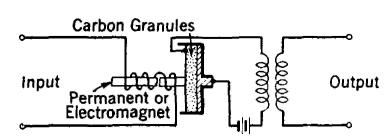| Electrical Communication is a free textbook on the basics of communication technology. See the editorial for more information.... |

|

Home  Telephone Toll Service and Systems Telephone Toll Service and Systems  Early Telephone Repeaters Early Telephone Repeaters |
|||






|
|||
Early Telephone RepeatersThe search for a satisfactory telephone repeater began early in the history of telephony and followed many lines.12,13 With the exception of the device now to be considered these investigations were without success. As explained on page 94, the carbon-granule transmitter is an amplifier. It follows therefore that a receiver element mechanically connected to a transmitter provides an amplifying element as illustrated in Fig. 4. The mechanical repeater element perfected by Shreeve was the most satisfactory device of the receiver-transmitter type, and in 1904 it was successfully used commercially between New York and Chicago.12 As can be seen from Fig. 3, the element consists of receiving windings which actuate the movable magnetic core. This is connected to a plunger varying the resistance of the carbon-granule path, thus controlling the output from a connected battery. The amplifying element of one model consisted of two main parts, the cartridge and the socket. The cartridge contained all the working parts likely to become defective in service and could readily be removed from the circuit and a new one substituted. The Shreeve repeater was, relatively speaking, widely used until the advent of the vacuum-tube repeater about 1913.
|
|||
Home  Telephone Toll Service and Systems Telephone Toll Service and Systems  Early Telephone Repeaters Early Telephone Repeaters |
|||
Last Update: 2011-05-30


